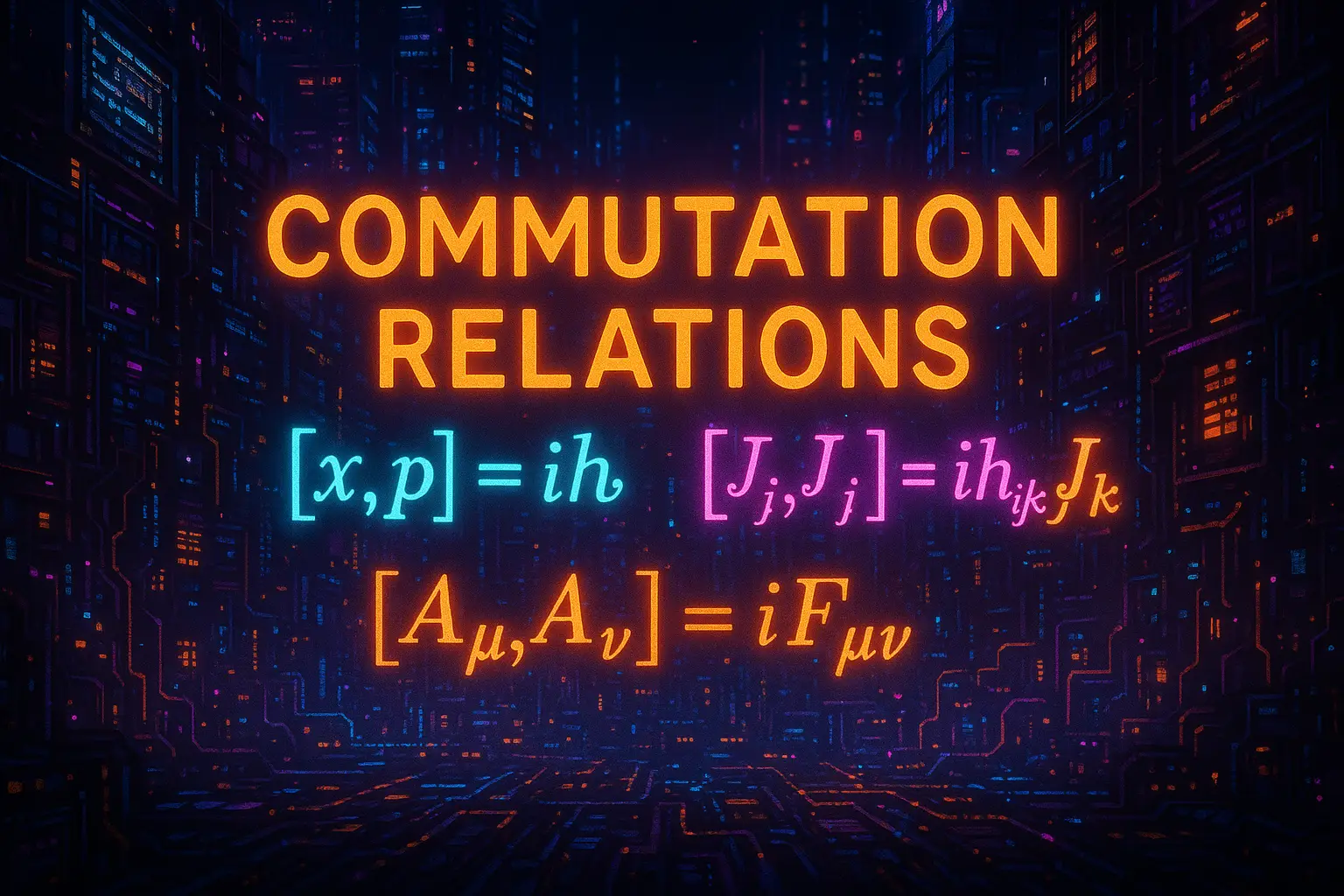Table of Contents
- Introduction
- Operators and Observables
- Definition of Commutator
- Mathematical Properties of Commutators
- Canonical Commutation Relations
- Position-Momentum Commutation
- Angular Momentum Commutation Relations
- Spin and Pauli Matrices
- Consequences for Measurement
- Commutators and Uncertainty Principle
- Lie Algebras and Structure Constants
- Commutator Algebra in Matrix Mechanics
- Time Evolution and Commutators
- Symmetries and Conserved Quantities
- Applications in Quantum Field Theory
- Conclusion
1. Introduction
Commutation relations are fundamental to the algebraic structure of quantum mechanics. They encode the non-commutative nature of quantum observables and lie at the heart of quantum dynamics, measurement, and uncertainty.
2. Operators and Observables
In quantum mechanics:
- Observables are represented by operators on a Hilbert space
- The order in which operators act matters:
\[
\hat{A}\hat{B} \neq \hat{B}\hat{A}
\]
This is a key departure from classical physics.
3. Definition of Commutator
Given two operators \( \hat{A} \) and \( \hat{B} \), the commutator is defined as:
\[
[\hat{A}, \hat{B}] = \hat{A}\hat{B} – \hat{B}\hat{A}
\]
- If \( [\hat{A}, \hat{B}] = 0 \): operators commute
- If not: they are non-commuting, and their measurements are incompatible
4. Mathematical Properties of Commutators
- Linearity:
\[
[\hat{A} + \hat{B}, \hat{C}] = [\hat{A}, \hat{C}] + [\hat{B}, \hat{C}]
\] - Jacobi Identity:
\[
[\hat{A}, [\hat{B}, \hat{C}]] + [\hat{B}, [\hat{C}, \hat{A}]] + [\hat{C}, [\hat{A}, \hat{B}]] = 0
\] - Commutator with product:
\[
[\hat{A}, \hat{B}\hat{C}] = [\hat{A}, \hat{B}]\hat{C} + \hat{B}[\hat{A}, \hat{C}]
\]
5. Canonical Commutation Relations
The most fundamental commutation relation in quantum mechanics:
\[
[\hat{x}, \hat{p}] = i\hbar
\]
Where:
- \( \hat{x} \): position operator
- \( \hat{p} \): momentum operator
It expresses the non-commutativity of phase space coordinates.
6. Position-Momentum Commutation
In one dimension:
\[
\hat{x} \psi(x) = x \psi(x), \quad \hat{p} \psi(x) = -i\hbar \frac{d}{dx} \psi(x)
\]
Then:
\[
[\hat{x}, \hat{p}] \psi(x) = i\hbar \psi(x)
\]
Confirms the canonical commutator.
7. Angular Momentum Commutation Relations
Angular momentum components \( \hat{L}_x, \hat{L}_y, \hat{L}_z \) obey:
\[
[\hat{L}_x, \hat{L}_y] = i\hbar \hat{L}_z
\]
\[
[\hat{L}_y, \hat{L}_z] = i\hbar \hat{L}_x
\]
\[
[\hat{L}_z, \hat{L}_x] = i\hbar \hat{L}_y
\]
These form the Lie algebra of the rotation group SO(3).
8. Spin and Pauli Matrices
Spin-1/2 observables are represented by Pauli matrices:
\[
[\sigma_x, \sigma_y] = 2i\sigma_z, \quad \text{and cyclic permutations}
\]
This reflects the algebra of angular momentum at the quantum level.
9. Consequences for Measurement
Non-commuting operators:
- Cannot be simultaneously diagonalized
- Cannot have well-defined values in the same quantum state
- Measurement of one affects the uncertainty of the other
10. Commutators and Uncertainty Principle
From:
\[
[\hat{A}, \hat{B}] = i\hat{C}
\]
We get:
\[
\Delta A \Delta B \ge \frac{1}{2} |\langle [\hat{A}, \hat{B}] \rangle|
\]
For position and momentum:
\[
\Delta x \Delta p \ge \frac{\hbar}{2}
\]
11. Lie Algebras and Structure Constants
If:
\[
[\hat{T}_a, \hat{T}_b] = i f^{abc} \hat{T}_c
\]
Then \( f^{abc} \) are the structure constants of a Lie algebra. Commutators encode the symmetry algebra of quantum systems.
12. Commutator Algebra in Matrix Mechanics
Heisenberg’s original formulation was built on:
- Matrix observables
- Operator algebra
- Time evolution governed by commutators:
\[
\frac{d\hat{A}}{dt} = \frac{i}{\hbar}[\hat{H}, \hat{A}] + \left(\frac{\partial \hat{A}}{\partial t}\right)
\]
This is equivalent to Schrödinger’s picture.
13. Time Evolution and Commutators
Heisenberg equation of motion:
\[
\frac{d\hat{A}}{dt} = \frac{i}{\hbar}[\hat{H}, \hat{A}]
\]
If \( [\hat{H}, \hat{A}] = 0 \), then \( \hat{A} \) is conserved — i.e., a constant of motion.
14. Symmetries and Conserved Quantities
Symmetry operations correspond to unitary operators:
- If \( \hat{U} \) is a symmetry:
\[
\hat{U}^\dagger \hat{H} \hat{U} = \hat{H}
\] - If \( [\hat{H}, \hat{G}] = 0 \), then \( \hat{G} \) is conserved
This forms the basis of Noether’s theorem in quantum systems.
15. Applications in Quantum Field Theory
- Creation and annihilation operators obey commutation (bosons) or anticommutation (fermions) relations
- Gauge symmetries are described via commutator algebra of field operators
- Commutators dictate causal structure in relativistic theories
16. Conclusion
Commutation relations are the algebraic engine of quantum mechanics. They define how observables interact, reveal the structure of quantum symmetries, and give rise to fundamental limits like the uncertainty principle. Understanding and manipulating commutators is essential for analyzing quantum systems in mechanics, information, and field theory.


